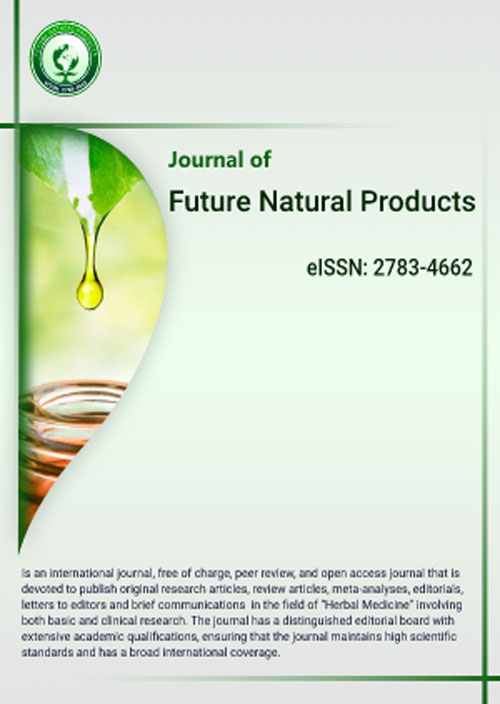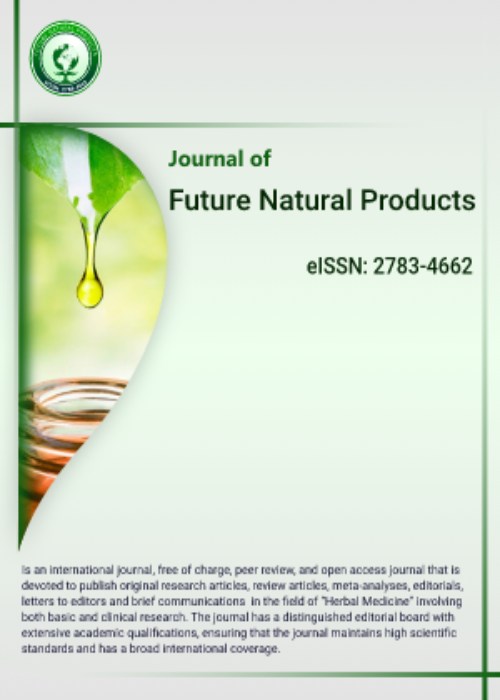فهرست مطالب

Future Natural Products
Volume:7 Issue: 2, Summer -Autumn 2021
- تاریخ انتشار: 1400/11/17
- تعداد عناوین: 5
-
Pages 1-11Background and aims
Pain is a human societies problems that has always had a lot of attention to control. However, some patients became resistance to analgesic effect of common analgesics. A main goal of the researches on the field of pain is to find effective medications with less side effects. In this regards, natural derivatives of medicinal plants are under considering of researchers. It has been determined that oxidative stress involved in the pathophysiology of pain. The aim of this study is to investigate the analgesic effect of quinic acid considering its possible antioxidative effects in male mice.
MethodsIn this experimental study, 40 male mice were divided into 4 groups (N=10) received normal saline (1 ml/kg), dexamethasone (5 mg/ kg), quinic acid (QA) (10 mg/kg) and QA (50 mg/kg) for 7 constant days via intraperitoneal route. Then, the pain response was assessed using hot plate test. Finally, mice were euthanized and hippocampi dissected out. The levels of malondialdehyde (MDA), nitrite as well as antioxidant capacity were measure in the hippocampus.
ResultsThe results showed that QA significantly increased the duration of delay in pain response to heat. Furthermore, QA significantly increased the antioxidant capacity as well as decreased the levels of MDA and nitrite in the hippocampus.
Conclusionwe concluded that QA, partially at least, through mitigation of oxidative stress (increased the antioxidant capacity as well as decreased the levels of MDA and nitrite) exerts analgesic effect in the hot plate test in male mice.
Keywords: Quinic acid, Pain, hot plate, Oxidative stress, Mice -
Pages 13-30Background and aimsGymnema sylvestre, commonly known as periploca of the woods, belongs to the family Asclepiadaceae. Several studies have reported that the plant possesses some medicinal properties. A wide variety of diseases such as cancer, diabetes, and cardiovascular disease in human are directly associated with oxidative stress. This study was aimed to examine the possible antioxidant activity of ethyl acetate and aqueous fractions of G. sylvestre.MethodsThe antioxidant property of the extract fractions was determined using in vitro assays, 2,2 - diphenyl-2-picrylhydrazyl (DPPH) and ferric reducing antioxidant potential (FRAP) methods. To identify compounds in the fractions with the antioxidant property, liquid chromatography-mass Spectroscopy (LC-MS) was carried out.ResultsEthyl acetate fraction showed the highest DPPH scavenging activity (significantly higher than the standard) [(88.98±2.69)% with lowest IC50 at 1.01±0.04 mg/cm3] compared to aqueous fraction [(83.86±0.64)% with highest IC50 at 1.04±0.01 mg/cm3] and standard ascorbic acid [(84.71±0.60)% and IC50 1.03±0.01 mg/cm3]. However the aqueous fraction was significantly weaker than the standard for DPPH scavenging activity. The FRAP assay yielded similar result to those of DPPH assay [(0.452±0.002)%, (0.426±0.000)%, and (0.425±0.001)% for ethyl acetate extract, aqueous extract and the standard (ascorbic acid), respectively]. LC-MS of the fractions revealed different compounds including C17H15O7, C27H20O18, C28H24O16 (in ethyl acetate extract) and C15H10O9S, C15H16O12, C27H26O16 (in aqueous extract). Molecular docking analysis of the identified compounds against some useful enzymes (alpha glucosidase and alpha amylase) suggested that these compounds could be a potential inhibitors of the enzymes.ConclusionTherefore, G. sylvestre leaf extract could be recommended as a potential natural antioxidant source that could be used in preventing oxidative stress-associated diseases and in drug management.Keywords: Antioxidant, In vitro, Gymnema sylvestre, Ethyl acetate, free radical, aqueous
-
Pages 31-43Background and aimsKidney injury is associated with serious short and long-term morbidities, increased risk of death and stupendous healthcare costs. The objective of this study was to investigate the therapeutic role of Kidney Revival (KR), an herbal formulation, on gentamicin-induced kidney injury in animals.MethodsThe antioxidant properties of KR were studied using the DPPH assay and hydrogen peroxide, nitric oxide and superoxide radical scavenging. Moreover, the therapeutic application of KR was studied in acute oral toxicity in mice and gentamicin-induced renal toxicity in rats. All clinical, pathological and biochemical features related to kidney injury were carefully studied.ResultsIn vitro experiments showed free radical scavenging properties of KR. Acute oral toxicity investigations revealed that KR was safe up to 2 ml/kg. Treatment with KR in gentamicin-induced nephrotoxic animals showed a significant (p<0.05) and dose-dependent enhancement of excretion of urea and creatinine. It also maintained electrolyte (sodium, potassium and chloride) balance in blood and counteracted oxidative stress in renal tissues. Histopathological findings also corroborated the results.ConclusionEnhancement of creatinine and urea excretion indicated that KR acted directly on renal tubules to modify glomerular filtration rate and its excretory functions.Keywords: Kidney, Glomerular Filtration Rate, Gentamicin, Antioxidant, Creatinine, Herbs
-
Pages 44-56Background and aimsThe beneficial effects of probiotics, especially yogurt, have drawn attention, but in the last few years, probiotic yogurts have received great attention due to their significant effects on health. Plants, including artichoke (Gundelia tournefortii L.), have many beneficial effects. In this study, the effect of yogurts containing G. tournefortii extract and kefir on lipid, lipoprotein pattern, calcium and phosphorus was compared with that of probiotic yogurts obtained from two microorganisms, Lactobacillus acidophilus and Bifidobacterium bifidum.Methods12 batches of probiotic yogurts were produced by Tamime method, along with kefir and G. tournefortii extract. The yogurts along with a high-fat diet were fed to 80 adult male Wistar rats for seven days. At the end of study, the serum levels of lipid, lipoproteins, calcium and phosphorous were measured using standard methods.ResultsThe effect of yogurt containing G. tournefortii extract was similar to those of probiotic yogurts in lowering serum cholesterol. Although yogurts containing G. tournefortii extract and probiotic yogurts pronouncedly reduced HDL-C, VLDL-C, LDL-C and triglycerides, the reduction was not statistically significant. There were no significant differences between the mean concentrations of phosphorous in different groups.ConclusionYogurts containing G. tournefortii extract have similar effects on the reduction of high-fat diet-induced hypercholesterolemia to those of probiotic yogurts containing L. acidophilus and B. bifidum. The usage of G. tournefortii extract 0.9%, kefir and 0.6 g L. acidophilus increases the calcium level compared to normal diet, but the other G. tournefortii extracts and probiotic yogurts do not affect calcium levels.Keywords: Gundelia tournefortii L, Kefir, lipid, Probiotic, Yogurt
-
Pages 57-72
One of the essential approaches to preventing the spread of COVID-19 is disease prevention methods. In this regard, medicinal plants are valuable. In this study the mechanisms and effects of effective medicinal plants for the prevention of COVID-19 in the Iranian pharmaceutical market were investigated. For this purpose, search terms Herbal Medicine, Phytotherapy, Traditional Medicine, Complementary Medicine, Alternative Medicine, Integrative Medicine, Prevention, SARS-CoV-2, and COVID-19 were used to retrieve relevant publications indexed in Scopus, ScienceDirect, Google Scholar, and PubMed until May 2021. After obtaining articles related to medicinal plants, articles that addressed plants in Iran were included in the review, then the mechanisms of their actions in the prevention of COVID-19 were investigated. According to the extracted studies, plants such as Zataria multiflora Boiss., Camellia sinensis (L.) Kuntze, Echinacea spp., Aloe vera (L.) Burm.f, Nigella sativa, eucalyptus spp., Cichorium intybus L., Syzygium aromaticum (L.), Glycyrrhiza glabra L., Allium sativum L., and Crocus sativus L. are effective in preventing COVID-19, which are found in the domestic market of Iran. These plants seem to effectively prevent COVID-19 with three fundamental mechanisms: anti-inflammatory and antioxidant effects, immunomodulatory effects, and inhibiting virus attachment to the host cell.
Keywords: Herbal Medicine, Phytotherapy, COVID-19, prevention, SARS-CoV-2


